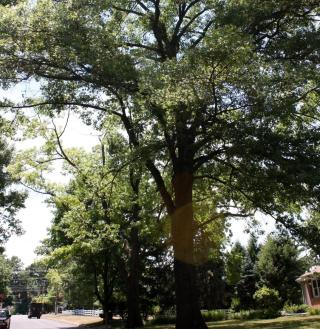How Can I Get a Tree for My Property?

Ferguson Township has a formal shade tree maintenance program in place to help ensure healthy and vibrant trees in our neighborhoods.
The Township is responsible for the trees located in the public right-of-way of Township roads, most often between the street and the sidewalks. A majority of new street trees are planted by developers at their cost when constructing new subdivisions. Once accepted, these trees become the property of and are maintained by the Township. The Township holds responsibility for trees planted within those identified areas, including monitoring, pruning, and removal if necessary while also looking for opportunities to expand green infrastructure with more trees planted. With our vast network of roads and shared green space areas, there is great potential for more trees within the Township.
In recent months, the Township Arborist and the Ferguson Township Tree Commission have been reviewing requests for removals of dying or dead trees, as well reviewing requests for trees to be added to the township’s streetscapes.
If you have a street tree in front of your property that is dead or unhealthy or if you would like to request a new street tree planting, please contact the Township Arborist at arborist@twp.ferguson.pa.us or (814) 238-4651 to add your location to the monitor and replacement list.
Beyond trees located in the Township rights-of-way, homeowners and landowners may be interested in expanding the diversity of native trees planted on their properties to support local fauna – pollinators, insects, and wildlife – to add to the aesthetic appeal of their properties.
If you’re wondering about species, the Township Tree Planting List can serve as a good starting point. While consisting mostly of native species and cultivars thereof, there are a few more well-behaved non-local species also included. You can also check out tree guides that indicate range of species – Pennsylvania is lucky as we have a wide range of species occurring – you can also get a sense of what is supposed to grow in the area by taking a walk in a forest near you. Brush up on your leaf and bark identification skills so you know what you’re looking at or take advantage of technology to help with ID. There are several great apps that allow you to take a picture of tree leaves or flowering plants. The app then returns information about species matching the image. iNaturalist, Leaf Snap, and the Virginia Tech Tree ID are just a few that users really enjoy.
In our area, landowners looking to plant larger numbers of trees can purchase bare-root seedlings in bulk (25 is the smallest number of seedlings that can be ordered) from the Pennsylvania Game Commission’s Howard Nursery in Howard. Seedling orders are scheduled to open January 10, 2022, for planting in April – before the tree seedlings break dormancy and start to grow. Their site contains a seedling order form and other information about species. Planting bare root seedlings requires less digging, but the seedlings will require good care and watering during the first, and potentially second, year of their lives to get established on the site. They are also considered incredibly tasty by our local herbivores (deer, rabbit especially) so tree protection, such as tree tubes or fencing, is important to consider.
Many of our local nurseries have native tree species available for sale. Trees are more likely to be containerized (1 to 5 gallon buckets) or balled and burlapped for larger sized stems. Most all will deliver within the area – you must dig the holes in advance of the tree’s arrival. Make sure you’re adequately watering during the first year or two of the tree’s life on site. It’s important to support good root growth to help the tree get established. Protection from herbivores is still important, but if the foliage and twigs are above the reach of deer and rabbits, the impact shouldn’t be too great.
Additionally, sometimes local plant groups or volunteer groups will offer native plant or tree seedling sales. Pay attention to community billboards and public service announcements to find out when those occur.
Trees contribute to the overall well-being of our communities, reducing energy costs, helping to clean up pollution, reducing noise, and increasing home values, in addition to their important role within the ecosystem for clean water, air, wildlife habitat and more. We depend on trees and forests for wood products, recreational opportunities, and economics, in addition to all the other benefits they provide. A healthy, diverse community forest will benefit all the inhabitants of Ferguson Township. Help find those opportunities to expand the impact of the trees.

